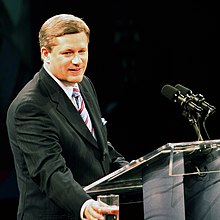Section 3 of the Canadian Charter of Rights and Freedoms
| Canadian Charter of Rights and Freedoms |
|---|
| Part of the Constitution Act, 1982 |
| Preamble |
| Guarantee of Rights and Freedoms |
| 1 |
| Fundamental Freedoms |
| 2 |
| Democratic Rights |
| 3, 4, 5 |
| Mobility Rights |
| 6 |
| Legal Rights |
| 7, 8, 9, 10, 11, 12, 13, 14 |
| Equality Rights |
| 15 |
| Official Languages of Canada |
| 16, 16.1, 17, 18, 19, 20, 21, 22 |
| Minority Language Education Rights |
| 23 |
| Enforcement |
| 24 |
| General |
| 25, 26, 27, 28, 29, 30, 31 |
| Application |
| 32, 33 |
| Citation |
| 34 |

Section Three of the Canadian Charter of Rights and Freedoms is a section of the Charter that constitutionally guarantees all Canadian citizens the democratic right to vote and the opportunity to represent their fellow citizens.
This is one of the rights in the Charter that cannot be affected by the notwithstanding clause, thereby preventing Parliament or the provincial governments from denying the vote to any citizens whom the courts believe can rationally hold it. Nevertheless, any decision as to who can rationally hold the vote will of course be guided by the section 1 Oakes test.
Text
Under the heading "Democratic Rights," the section reads:
3. Every citizen of Canada has the right to vote in an election of the members of the House of Commons or of a legislative assembly and to be qualified for membership therein.
Interpretation
Generally, the courts have interpreted section 3 as being more generous than simply providing a right to vote. As stated in the case Figueroa v. Canada (2003),[1] the section has been viewed as a constitutional guarantee to "play a meaningful role in the electoral process," which in turn encourages governmental "respect for a diversity of beliefs and opinions." This does not mean, however, that interest groups have complete freedom to promote their beliefs and opinions. Since the voter must have an opportunity to balance various ideas in his or her own mind before meaningfully participating in an election, the Supreme Court has, in the case Harper v. Canada (Attorney General) (2004),[2] upheld laws that limit the amount of money a single group can contribute in an election (to prevent a monopolization of the campaign).
Suffrage
No formal right to vote existed in Canada before the adoption of the Charter. There was no such right, for example, in the Canadian Bill of Rights. Indeed, in the case Cunningham v. Tomey Homma (1903), it was found that the government could legally deny the vote to Japanese Canadians and Chinese Canadians (although both groups would go on to achieve the franchise before section 3 came into force).[3]
The section has generated some case law expanding the franchise. In 1988, section 3 had been used to grant suffrage to federal judges and those in mental institutions. A more controversial example is Sauvé v. Canada (2002),[4] in which it was found that prisoners could vote. They did so in the 2004 federal election, despite public opposition from Conservative leader Stephen Harper.[5]
Sizes of constituencies
Although one cannot see this on the face of the Charter, the Supreme Court has also ruled that section 3 guarantees a measure of equality in voting. In Reference re Prov. Electoral Boundaries (Sask.) (1991)[6], it was found that constituencies should have roughly the same number of voters, although perfection was not required. The reasoning behind this expansion of section three's meaning was that it supposedly reflected the original purpose of the section, namely to allow "effective representation." The concession that perfection is not required stemmed from the fact that perfection would be impractical, given geographical limits in drawing boundaries and a general desire to give minorities more representation. While Saskatchewan's constituencies were found to be valid in the 1991 decision, Prince Edward Island's were later deemed unconstitutional by the courts and the province's electoral map had to be redrawn.
Referendums
While section 3's reach has been expanded to cover the sizes of constituencies, it has not been extended to guarantee the right to vote in a referendum. In Haig v. Canada (1993),[7] it was ruled that since section 3 was designed in specific reference to electing representatives, the right could not include participation in a "device for the gathering of opinions." It was also noted that unlike elections, governments do not have to hold referendums, nor do governments have to commit themselves to the result of a referendum. Thus, how a referendum is administered is within governmental discretion.
References
External links
- Overview of section 3 case law in the Canadian Legal Information Institute.
Notes
- ^ Figueroa v. Canada (Attorney General) 2003 SCC 37 (CanLII), [2003] 1 S.C.R. 912.
- ^ Harper v. Canada (Attorney General), 2004 SCC 33 (CanLII).
- ^ Hogg, Peter W. Canada Act 1982 Annotated. Toronto: The Carswell Company Limited, 1982.
- ^ Sauvé v. Canada (Chief Electoral Officer) [2002] 3 S.C.R. 519.
- ^ CBC.ca, "12,500 prisoners get to vote on June 28," Thu, 03 Jun 2004 09:28:42 EDT.
- ^ Reference re Prov. Electoral Boundaries (Sask.), [1991] 2 S.C.R. 158.
- ^ Haig v. Canada, 1993 CanLII 58 (S.C.C.), [1993] 2 S.C.R. 995.
